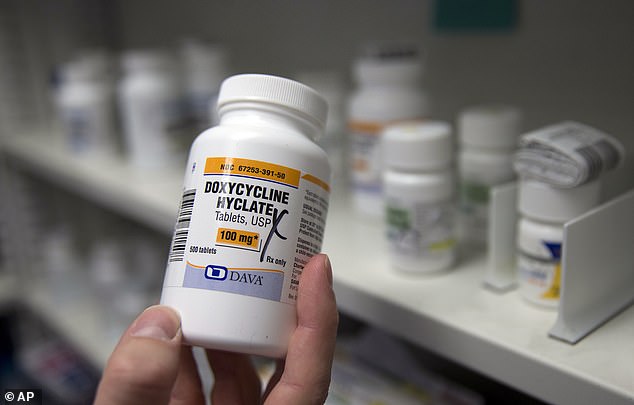Doctors have discovered nearly 60 common drug combinations that could put millions of Americans at risk of deadly complications.
Taking popular medications such as warfarin, a blood thinner, with some antibiotics, or combining blood pressure pills with turmeric supplements, could render life-saving medications ineffective or lead to a dangerous unintentional overdose.
It means that at least 20 million Americans who rely on these heart disease medications could be unknowingly putting themselves at mortal risk of having a heart attack, stroke or serious bleeding.
The study, conducted by researchers at the Massachusetts Institute of Technology, uncovered a staggering 2 million potentially harmful interactions, 58 of which had not been previously documented.
Scientists warned that the antibiotic doxycycline, available by prescription, could interact with the drugs warfarin, a blood thinner, and tacrolimus, an immune system suppressant (stock)
Interactions detected included the antibiotic doxycycline or periostat, used to treat pneumonia. and sexually transmitted diseases (STDs) and warfarin, prescribed each year to about 14 million Americans with heart disease.
Combinations of the heart failure drug digoxin, the anticonvulsant levetiracetam, and the immunosuppressant tacrolimus were also found to be risky.
Specifically, a drug is either super-metabolized, meaning patients receive a higher dose than they need, or undermetabolized, meaning they receive too little.
The researchers explained that the problem lies in the way the body processes medications.
All oral medications are metabolized through one of the few specialized transporter proteins in the intestines.
Sometimes drugs compete for the same carrier proteins, so patients receive too little medication. In some cases, this means that patients receive too high a dose.
For the study, published in the journal Nature Biomedical EngineeringThe researchers analyzed 23 commonly used prescription and over-the-counter medications, as well as 28 less commonly used medications and more than a thousand experimental medications.
They exposed each of the drugs to cells from a pig’s intestine, to simulate how the drug would be metabolized in the human body.
They blocked one of three transporter proteins in the cells and controlled the amount of drug left in the tissue.
If very little drug was detected, this revealed the transporter protein it used.
The researchers fed the data into a machine learning model to calculate which drugs were likely to use the same transporter.
Predicted nearly 2 million interactions, including 58 that were previously unknown.
In a second part of the study, researchers examined blood test data from 50 patients who were prescribed doxycycline.
Each had previously been taking warfarin, digoxin, levetiracetam, or tacrolimus.
The results showed that patients taking warfarin received a “super dose” of the drug when given along with doxycycline.
Too much warfarin can prevent the blood from clotting, increasing the risk of gastrointestinal bleeding, nosebleeds, and bleeding under the skin.
Dr Traverso added: “These are commonly used drugs and we are the first to predict this interaction using this accelerated in silico and in vitro model.”
“This type of approach allows us to understand the potential safety implications of giving these drugs together.”
Dr Giovanni Traverso, a gastroenterologist who participated in the study, said: “One of the challenges in modeling absorption is that drugs are bound to different transporters.
“This study is about how we can model those interactions, which could help us make drugs safer and more effective. [work better].
‘[It could also help us to] predict potential toxicities that may have been difficult to predict until now.’
Experts suggest that patients should wait several hours (usually four to six hours) between taking the above medications to reduce the risk of interactions.


